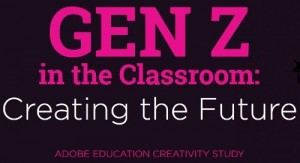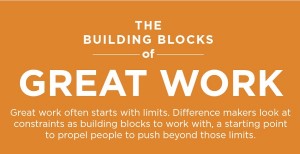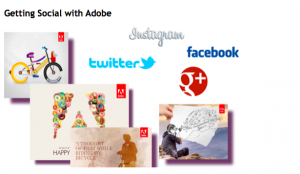How Adobe Sells Without Selling
- At May 09, 2017
- By rbadmin
- In Uncategorized
 0
0
The folks at Adobe are master content marketers. They have proven over and over again that you can build your customer base and boost your company’s revenue by dedicating a tremendous amount of resources to producing content.
Take a look at AdobeEducate.com. It’s a website that we at reddbug built for them last year as a way to reach out to educational institutions before and during a big education conference in Anaheim, California.
First, though, Adobe partnered with the PR firm Edelman to conduct a huge study about Generation Z, today’s youngest generation after the Millennials. They surveyed more than a thousand kids and asked them how they learn, how they express themselves creatively, how they see the future and so on. The results are fascinating, especially since the vast majority of us have hardly read anything about America’s youngest generation.
Adobe did this work, asked us to publish it and launched it at the conference because they hoped to sell education products to educational institutions. At the same time, though, what they’ve done here counts as genuine social science research.
Those who are still skeptical about the value of content marketing may be skeptical that something as seemingly off-topic as social science research could possibly boost a technology company’s bottom line, but look at the results. Adobe’s study made a huge splash at the education conference. Nearly 20,000 people looked at the website and generated hundreds of thousands of page impression and thousands of downloads. And many of the people who were wowed by the material are Adobe’s new customers.
If you’d like to enlist reddbug’s help with your own company’s website, infographics or other digital campaigns, give us a holler.
An Elegantly Simple Web Presentation
- At May 08, 2017
- By rbadmin
- In Uncategorized
 0
0
Tintri is an American IT company based in Mountain View, California, that creates software to provision and manage physical and virtual machines. More than almost anyone else in the market, they make complex processes simple.
When prospective customers sit down for a one-on-one demonstration, the usual reponse is one of amazement. They’re wowed. And the first thing they want to know is how they can buy it.
Tintri’s sales people have it easy. The problem is that it’s hard to convey how impressive the software is using traditional marketing materials. The wow factor can’t quite be captured in a brochure or on a traditional website.
So Tintri asked us to design and build a web experience microsite called the Explore Tintri Hub to emulate an in-person product demonstration. Potential customers can walk through the usual challenges they face when provisioning machines and see for themselves exactly what Tintri’s software does and how it can help them. They don’t read or hear that Tintri reduces complex processes to mere seconds—they experience it.
Take a look for yourself even if you don’t know the first thing about provisioning and managing physical or virtual machines. The beauty here is the experience. The microsite will walk you through, click by click, configuring Tinti for the first time in less than 30 seconds. What should be extraordinarily complicated will seem as simple as installing an app on your phone.
It works because it’s interactive, elegantly simple, and demonstrates Tintri’s software perfectly. Potential customers can find the site on their own, the company can direct people to it, and the sales team actually sits down with potential customers while they go through it.
Spend just a few minutes clicking around and you’ll see why the Explore Tintri hub is by far the best performing sales tool and lead generator that the company, with reddbug’s help, has ever created. And if you’d like to hire us to develop a similar web experience presentation for one of your own company’s products, contact us.
The Building Blocks of Great Work
- At April 03, 2017
- By rbadmin
- In Uncategorized
 0
0
O.C. Tanner is not what it used to be.
Founded in 1927 as a jewelry company in Utah by Obert C. Tanner, its reputation for world class craftsmanship won it the honor of producing the gold and silver medals for the Salt Lake City Olympics in 2002. As it did during the Summer Games fifteen years ago, today O.C. Tanner focuses on inspiring and rewarding others’ great work.
“Celebrating great work inspires people to invent, to create, to discover,” the company says. “And when people are inspired, companies grow.” One of its executives, David Sturt, even wrote a New York Times bestselling book called Great Work.
Great companies have always rewarded their employees for producing great work, and O.C. Tanner came up with a novel solution. Board members and managers can reward outstanding employees with points that can be used to order any gift they want for themselves from O.C. Tanner’s website.
It’s cited as one of Fortune magazine’s 100 best places to work. You should not be surprised to learn that a substantial portion of Fortune’s other 100 best places to work are O.C. Tanner’s clients. (Companies that don’t reward great work don’t make Fortune’s list.)
The company launched a campaign defining great work and asked us here at reddbug to design some infographics for them. One of those infographics told a fascinating story about, of all things, Lego blocks.
In 1974, the Lego company said there were 102,981,500 unique combinations in their standard block set. You’d think, with a number that large, that they must have done some serious mathematical modeling that at least came close to calculating the correct number, but nope. They assumed every stack of Legos would include no more and no fewer than six blocks.
So in 2005, Soren Eiler came along and wrote a program to find the true number. His computer crunched the equations for an entire week before finally calculating the answer, and get this: it turns out that there are actually 915,103,765 unique combinations, almost nine times as many as Lego claimed back in 1974. Now that’s some great work.
With reddbug’s help, O.C. Tanner’s campaign was viewed thousands of times, netting a number of leads and new clients. And remember, O.C. Tanner’s clients are enterprise companies. Just one can yield enough revenue to pay the salaries of several of their own great employees for an entire year.
If you’d like to hire reddbug to help your company with one or more of your own inspiring marketing campaigns, contact us.
Pluralsight Knocks it Out of the Park
- At January 31, 2017
- By rbadmin
- In Blog
 0
0
Pluralsight is an on-demand technology learning company based in Utah. They publish thousands of training videos on the web that teach professionals everything they need to know about development languages, IT ops, game design, graphic design and so much more.
It’s like Lynda.com, only much more advanced. You can log in and test your skill level so you don’t have to waste time going over material you already know.
Pluralsight even provides mentors who are available 24/7 so you don’t have to throw your laptop out the window when you get stuck.
The company wanted more people to come to their website and sign up, so they asked reddbug to lend a hand with a pay-per-click campaign. We developed the strategy, wrote the content, created ads and banners using their branding, and launched ads in all the usual pay-per-click channels like Google AdWords. Together we targeted English-speaking people all over the world, not just in the United States.
Every single measurable metric increased during our six-month campaign. Pluralsight had a 26 percent monthly average click-thru rate for first time viewers of the ads. That number that is almost unheard of. The industry average is less than one percent.
Then we topped it off with a massive remarketing campaign, which displayed Pluralsight ads around the Internet to everyone who previously visited the website. We increased conversions even 90 days after users saw the first ad.
If you’d like us to help your company with your own pay-per-click or remarketing campaigns, contact us.
Getting Social with Adobe
- At January 23, 2017
- By rbadmin
- In Blog
 0
0
Adobe’s social media marketing is an enormous and complex operation.
A company of Adobe’s size has not one but dozens of social media personas for various products—an Instagram account for Photoshop, a Twitter account for some of their other products, a Facebook account for nearly all their products, and so on, and they have whole teams managing these accounts.
Most people know Adobe for their suite of Creative Cloud products like Photoshop, Illustrator and InDesign. This been Adobe’s bread and butter since its founding, but there’s another side to their business as well—the Digital Marketing Cloud.
In 2009, Adobe acquired Omniture, an online marketing and web analytics business, and since then they’ve developed some of the best marketing solutions in the business, from Adobe Audience Manager to Adobe Media Optimizer.
For one of their products on the digital marketing side—Adobe Creative Cloud for Teams—the company asked us to provide some of the imagery and content for its social media channels.
So we created some artwork for Adobe’s Facebook, Twitter and Instagram pages. Social media accounts like these require a huge amount of curated content, and we had a blast creating some of it for them, partly because we wanted to show the world the awesome things you can create with Photoshop, Illustrator and Acrobat.
And we planned our content well into the future. We created artwork for the annual Ride Your Bike to Work day a month ahead of time, for example, and Adobe placed it into storage until it was needed.
The number of “likes” Adobe received thanks in part to our content went way up. We even created the imagery for the one millionth Facebook “like” for Adobe Creative Cloud for Teams!
We’re looking forward to creating even more artwork and content in 2017 for Adobe as well as our other wonderful clients.
Happy New Year!





